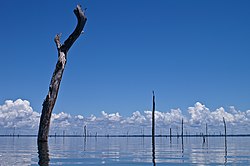Brokopondo Reservoir
| Brokopondo Reservoir | |
|---|---|
 |
|
| Coordinates | 4°48′N 55°4′W / 4.800°N 55.067°WCoordinates: 4°48′N 55°4′W / 4.800°N 55.067°W |
| Type | Reservoir |
| Primary inflows | Suriname River |
| Primary outflows | Suriname River |
| Catchment area | 12,200 km2 (4,700 sq mi) |
| Basin countries | Suriname |
| Surface area | 1,560 km2 (600 sq mi) |
| Water volume | 20 billion cubic metres (16×106 acre·ft) |
The Brokopondo Reservoir, officially named Professor Doctor Ingenieur W. J. van Blommestein Meer, and also called the Brokopondostuwmeer, is a large reservoir in Suriname. It is named after the Surakarta-born Dutch hydrological engineer Willem Johan van Blommestein. With a surface area of approximately 1,560 km² (602 mi²), depending on the current water level, it is one of the largest reservoirs in the world, flooding nearly one percent of the country.
The reservoir was created by constructing Afobaka Dam across the Suriname River between 1961 and 1964. The dam spanning the river is 54 m (177 ft) tall, and is built near the small town of Afobaka. Contrary to the reservoir's long official name, it was quickly rechristened Brokopondomeer by Dutch-speaking locals, after the town of Brokopondo two miles further downstream from where the dam was constructed. The length of the dam, including secondary dams along the margins of the reservoir, is 12 km (7.5 mi). The watershed which feeds the reservoir is 12,200 km² (4,710 mi²) in area.
The reservoir was put into service in 1965, but did not reach its optimal water level until 1971. Due to the great area of the reservoir, villages home to approximately 5,000 people had to be abandoned. The largest of these, the village of Ganzee, had approximately 2,000 residents. Most displaced residents simply founded new villages (Dutch: transmigratiedorpen) downstream from the dam, in many cases with the same names as the previously abandoned hamlets. A separate government operation, "Operation Gwamba," was conducted to save animals from the soon-to-be lake bed.
The dam was constructed in order to provide electricity to plants involved in the processing of bauxite into alumina, and later into purer aluminum metal. These plants were operated by Suralco, the Suriname Aluminum Company, which is a daughter company of Alcoa. About 75% of the dam's electricity was used to power these plants, and the portion of the electricity produced by the dam was used to power Suriname's capital city, Paramaribo. Other advantages of the dam's construction, besides a boost to the aluminum industry, have included the development of the country's inland areas and the surrounding forests, the pushing back of the saltwater boundary in the Suriname River, better irrigation capabilities during times of drought, an increase in tourist activity, and an increase in ease of fishing.
...
Wikipedia
